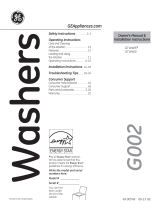Operating Instructions Safety Instructions
Consumer Support
Troubleshooting Tips
Before you call for service…
PERFORMANCE (cont.) Possible Causes What To Do
Pilling Result of normal wear on • While this is not caused by the washer, you can slow the
poly-cotton blends and pilling process by washing garments inside out.
fuzzy fabrics
Snags, holes, tears, rips Pins, snaps, hooks, sharp • Fasten snaps, hooks, buttons and zippers.
or excessive wear buttons, belt buckles,
• Remove loose items like pins, objects in pockets and
zippers and sharp objects
sharp buttons.
left in pockets
• Turn knits (which snag easily) inside out.
Undiluted chlorine bleach • Check bleach package instructions for proper amount.
• Never add undiluted bleach to wash or allow clothes to
come in contact with undiluted bleach.
Chemicals like hair bleach or • Rinse items that may have chemicals on them before
dye, permanent wave solution washing.
Wrinkling Improper sorting • Avoid mixing heavy items (like work clothes) with light items
(like blouses).
• Try a fabric softener.
Overloading or incorrect • Load your washer so clothes have enough room to move
water level freely with water covering all of the clothes.
Incorrect wash and • Match Cycle selection to the type of fabric you are washing
dry cycles (especially for easy care loads).
Repeated washing in • Wash in warm or cold water.
water that is too hot
SOUNDS Possible Causes What To Do
“Metallic clicking” Shifter mechanism is • The drive system will engage at the start of agitate and
engaging or disengaging disengage when agitate is complete. This occurs multiple
times during the wash.
Back and forth “swoosh” Electric motor reversing • This machine has a drive system that doesn’t use gears.
or light “clicking” sound direction This sound is the motor rotating back and forth to agitate
during agitate your laundry.
Quick short agitation Clothing redistribution • At the end of agitate, the motor makes short agitation strokes
sounds at end of agitate to redistribute the load.
“Click” when water Relay switch • The relay makes a click sound when activated. The water
stops filling level activates the relay and stops filling.
“Clicking” behind Control Automatic Temperature • This valve mixes in cold and hot water. The “clicking” is the
Panel during fill Control Valve valve turning on and off.
Water volume changes Automatic Temperature • This valve mixes in cold and hot water. The sound changes
during fill Control Valve when the valves are turned on and off.
Motor “whining up” or Motor ramping up/down • The motor will speed up incrementally during the spin cycle.
“coasting down” in spin during spin cycle When spin is complete, it will coast until it stops.
“Humming” Water drain pump • The drain pump will make a humming sound when pumping
out water after agitation stops and continue until spin is
complete.
“Gurgling” Water drain pump • When the pump starts drawing in air, It starts to gurgle.
The washer should then begin spinning and the sound will
continue until it is done spinning.
12
Troubleshooting Tips

















